
Starfish or sea stars are star-shaped echinoderms belonging to the class Asteroidea. Common usage frequently finds these names being also applied to ophiuroids, which are correctly referred to as brittle stars or basket stars. Starfish are also known as asteroids due to being in the class Asteroidea. About 1,900 species of starfish occur on the seabed in all the world's oceans, from warm, tropical zones to frigid, polar regions. They are found from the intertidal zone down to abyssal depths, at 6,000 m (20,000 ft) below the surface.
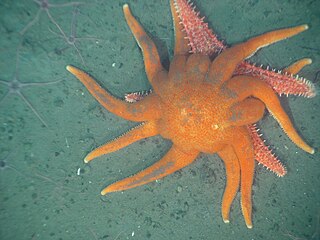
The Valvatida are an order of starfish in the class Asteroidea, which contains 695 species in 172 genera in 17 families.

The Echinasteridae are a family of starfish in the monotypic order Spinulosida. The family includes eight genera and about 133 species found on the seabed in various habitats around the world.

Solaster paxillatus, the orange sun star, is a species of starfish found at varying depths in the northern Pacific Ocean. It is a natural predator of the starfish Asterias amurensis.
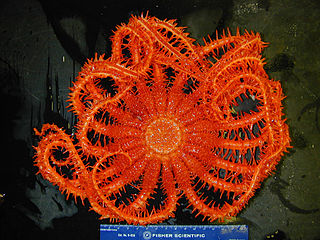
The Brisingids are deep-sea-dwelling starfish in the order Brisingida.

Henricia is a large genus of slender-armed sea stars belonging to the family Echinasteridae. It contains about fifty species.
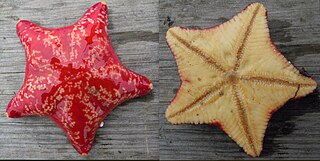
Poraniidae is a family of starfishes in the order Valvatida.

Porania is a genus of starfish in the family Poraniidae in the order Valvatida.
Henricia lisa is a species of starfish in the family Echinasteridae found in deep water in the northern Atlantic Ocean.
Paulasterias mcclaini is a species of starfish in the family Paulasteriidae. It is found in deep water at hydrothermal vents.
Paulasterias tyleri is a species of starfish in the family Paulasteriidae. It is found in deep water at hydrothermal vents in the Antarctic. It is the type species of the newly erected genus Paulasterias, the only other member of the genus being Paulasterias mcclaini.

Asterodiscides truncatus, the firebrick starfish, is a species of five-armed starfish in the family Asterodiscididae. It is native to eastern and southern Australia, the Norfolk Ridge and the Kermadec Islands of New Zealand.
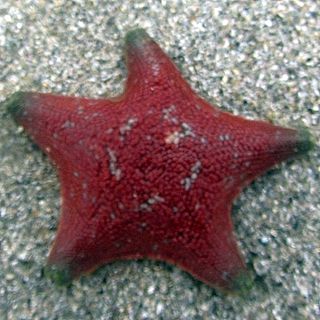
Patiria chilensis is a species of starfish in the family Asterinidae. It is found in the southeastern Pacific Ocean along the coasts of South America. It is a broadly pentagonal, cushion-like starfish with five short arms.
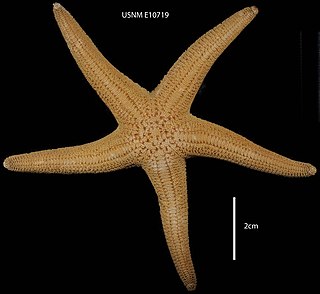
Stichaster striatus, the common light striated star, is a species of starfish in the family Stichasteridae, found in the southeastern Pacific Ocean. It was first described by the German zoologists Johannes Peter Müller and Franz Hermann Troschel in 1840.
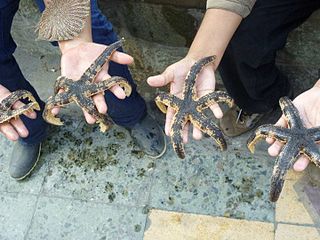
Luidia magellanica is a species of starfish in the family Luidiidae. It is found in the southeastern Pacific Ocean on the coast of South America.

Meyenaster is a genus of starfish in the family Asteriidae. It is a monotypic genus and the only species is Meyenaster gelatinosus which was first described by the Prussian botanist and zoologist Franz Julius Ferdinand Meyen in 1834. It is found in the southeastern Pacific Ocean on the coasts of South America.
Henricia sexradiata is a species of starfish in the family Echinasteridae. It is native to the western Atlantic Ocean and the Gulf of Mexico.
Henricia oculata, commonly known as the bloody Henry starfish, is a species of starfish in the family Echinasteridae. It is native to northwestern Europe. It was first described as Asterias oculata by the British zoologist Thomas Pennant in 1777, later being transferred to the genus Henricia.
Asterocheres lilljeborgi is a species of copepod in the family Asterocheridae. It is found in the British Isles and Scandinavia where it is a semi-parasite of starfish. First described as Asterocheres lilljeborgi in 1859 by the Norwegian marine biologist Jonas Axel Boeck, it is the type species of the genus.












